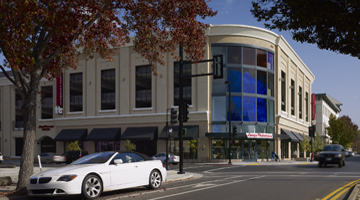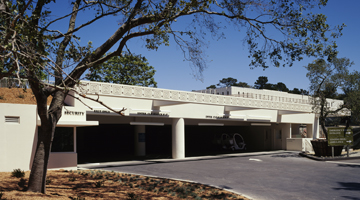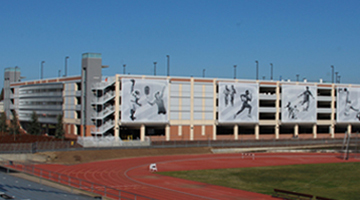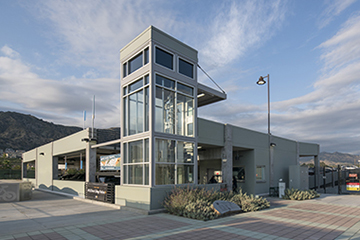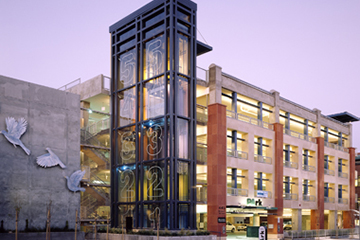Parking structures are often viewed as necessary evils of pure function. If you build it, they will come –if they have a place to park. But what if we thought of parking structures as more than just a place to store a vehicle? From downtowns and medical centers to college campuses and mixed-use developments, decision makers are coming to realize that parking can either enhance or detract from the arrival experience. From public art to public spaces to parking amenities, there are a number of best practices that can be utilized to elevate parking beyond the functional, integrate it into the larger whole and make it a transformative experience.
Transformative Parking: How Parking Can Create Better Destinations
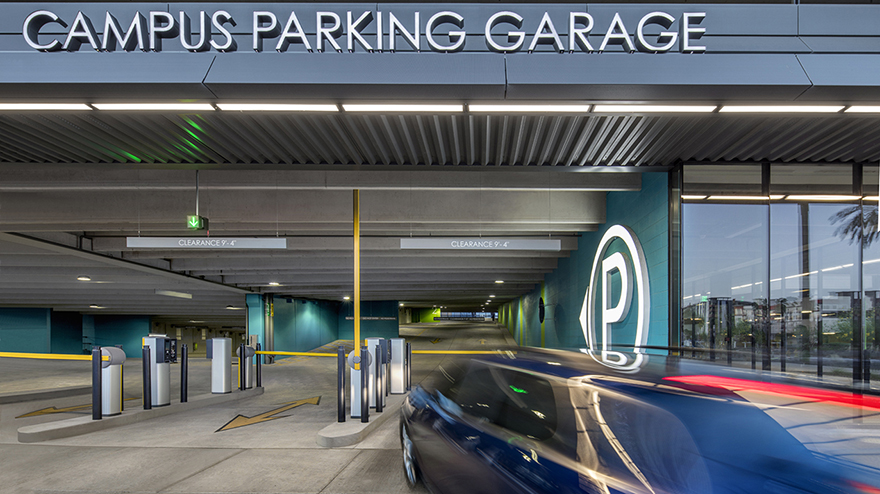
Making a First Impression
How many times have you thought about going somewhere, be it a downtown core, mixed-use center or college campus, only to cringe at the thought of having to park? Before even setting foot out the door, you have already created a negative impression about the experience you are about to have. Now imagine how different you might feel if parking was not only a seamless, stress-free endeavor, but it also enriched the experience?
This is the approach that the city of Santa Barbara took with the Granada Garage, which presents a treasure trove of Mission Revival architectural details that is makes parking a destination in and of itself. From the wrought iron balconies to terra cotta vases and detailed custom signage, the Granada Garage acts a spectacular welcome for visitors to downtown.
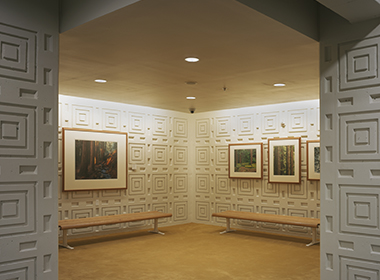 Elevator lobby in the Community Hospital of the Monterey Peninsula parking structure
Elevator lobby in the Community Hospital of the Monterey Peninsula parking structure
That welcoming feeling doesn’t have to be restricted to exterior architecture. Upon entering the Phoenix Biomedical Campus parking structure in Arizona, instead of the drab, nondescript walls typical of most parking structures, users are greeted with bold colors and imaginative signage that sets the tone for the rest of their visit.
The Community Hospital of the Monterey Peninsula saw parking as an opportunity to ease patient stress and create a relaxing experience. Different styles of music on each parking level calm patients and visitors and help them remember where they parked. Color coded pictograms and orientation maps that provide easy wayfinding, and ornate elevator lobbies designed to facilitate patient discharge feature soothing artwork and benches. In the same way that a clean house can help a visit with a guest get off on the right foot, these enriched parking experiences ensure that the first impression a visitor has is a positive one.
Celebrating Identity
Public art presents an opportunity for communities to transform parking structures from the utilitarian to an expression of place. If we think of parking as the first impression visitors have of their destination, public art can provide a way to celebrate identity and forge a more human, intimate connection with a space. For instance, when the Metro Gold Line Foothill Extension was constructed through Arcadia, Monrovia, Irwindale and Azusa, each city used public art to express its unique history at their respective station and parking structure, creating an experience for visitors at the moment of both their arrival and their departure. Seeing the potential, the City of Boulder is currently exploring an initiative to install public art on existing garages in an effort to create “gateways” to the city.
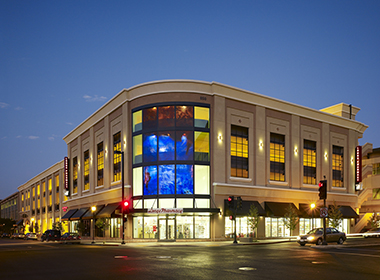 Beautiful stained glass panels greet visitors at a parking structure in downtown Mountain View
Beautiful stained glass panels greet visitors at a parking structure in downtown Mountain View
The same can be true for mixed use developments and campuses. Stanford University Medical Center incorporated art and sound to create an interactive environment for parkers at one of their subterranean garages. Olympia Place, a mixed-use development in Walnut Creek, California, used a beautiful copper sphere sculpture as a parking structure’s focal point. The city of Mountain View welcomes visitors to their downtown mixed-use structure with stunning stained glass panels that are even more dramatic at night. By integrating public art into their parking, these institutions are creating an arrival and departure experience that leaves a lasting impression.
Providing an Experience
Public spaces, such as plazas or parkletts, create a means for people to interact with each other and their environment in meaningful ways as they transition from their vehicles to pedestrian areas. These spaces create a reason for people to linger, be it to enjoy the scenery or socialize, leading to greater value for an area as a whole. Just imagine if upon parking your car, instead of exiting into a concrete alley or onto a busy intersection, you traveled through a landscaped plaza with park benches and live music on the way to your destination. Suddenly, parking is part of that experience instead of an isolated component – and in a positive way.
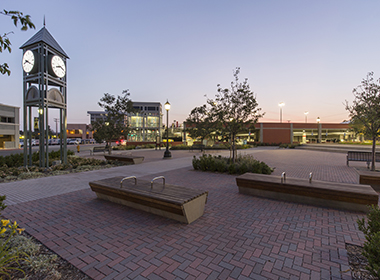 A public plaza creates a sense of community at the Arcadia Metro Gold Line parking structure and station
A public plaza creates a sense of community at the Arcadia Metro Gold Line parking structure and station
This is proving to be an effective approach for transit stations. The City of Arcadia chose to nestle a public plaza between a parking structure and the Metro Gold Line Arcadia Station, envisioning it as a way to create a sense of community between the parking structure and multiple transportation modes, from the station and bus stops to bicycle and pedestrian facilities. A parking structure for the forthcoming Milpitas BART extension will include a landscaped urban plaza capable of hosting food trucks.
Cities and transit stations are not the only ones that can benefit from integrating public space into parking structures. At UC Davis Medical Center, a courtyard plaza infused with public art sculptures and a variety of colorful trees provides patients transitioning from the parking structure to the hospital with a pleasant, relaxing environment designed to make their experience less stressful. The design team for the Phoenix Biomedical Campus parking structure worked with the City of Phoenix to create a new public plaza and green space out of an underutilized utility island west of the site, transforming urban infrastructure into a community experience.
Creating Connections
Much like with public spaces, by designing an enriched pedestrian experience into the journey we ultimately create a better destination. This means going beyond simply providing a means to get from point A to point B simply and safely. How does that transition add to the experience? In what ways can we take the opportunity to set the tone for the next stage of the journey?
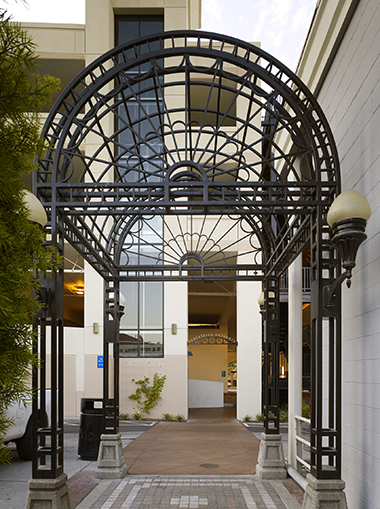 A gazebo at the Mountain View parking structure creates a richer experience for users traveling to downtown dining and shopping
A gazebo at the Mountain View parking structure creates a richer experience for users traveling to downtown dining and shopping
By accenting a pedestrian path with a wrought iron gazebo, the City of Mountain View was able to create a richer experience for users traveling between a parking structure and Castro Street, a hub for downtown dining and shopping. Likewise, the Granada Garage features two pedestrian paseos that guide users to local businesses, including the Granada Theater. The structure itself features a grand stair that points visitors to the city library. Both cities created pedestrian connections that not only improved the quality of the journey, but also enriched the overall experience.
American River College saw the benefits this approach could bring to the campus environment. Their parking structure not only solved some challenging modal conflicts by creating a pedestrian bridge to separate foot and vehicular traffic, but the college also saw it as an opportunity to foster community. A grand staircase incorporated into the design has become a focal point for campus gathering.
Enriched Experiences
When we take a more holistic view of the arrival experience, parking can be so much more than a simple means to an end. With valet parking, it can become an amenity. For example, at The River Oaks District, a high-end mixed use development in Houston, Texas, valet stations located throughout the development allow patrons to drop their vehicle off at one location and pick it up at another, as well as to have packages delivered directly to their car. Instead of viewing parking as an isolated component, The River Oaks District utilized it to deliver an ‘A’ list experience for their customers.
Lumina Towers in San Francisco took a similar approach with their residents. Instead of treating parking as an inconvenient necessity, they chose to incorporate it into the development’s luxury lifestyle in the form of valet parking. Tenants and visitors can leave their vehicles at a central valet drop off and pick up location. Retrieving a car is as simple as making the request via a mobile app, arriving at the pick up area, obtaining the keys and driving away. The valet service also provides additional amenities such as EV charging and dry cleaning drop off and pick up, adding even more convenience for residents.
Regardless of the location or user group, it’s possible to make an impression in an unexpected way at the origin of the user experience – when they park their car.


